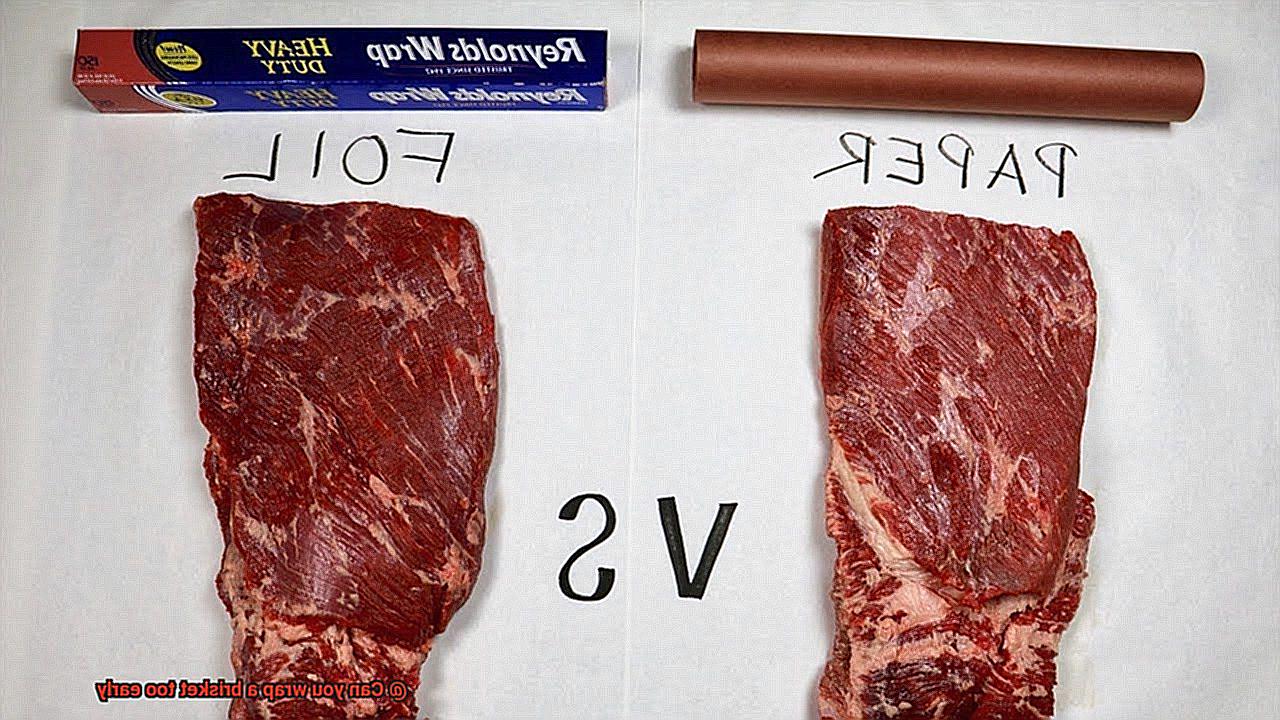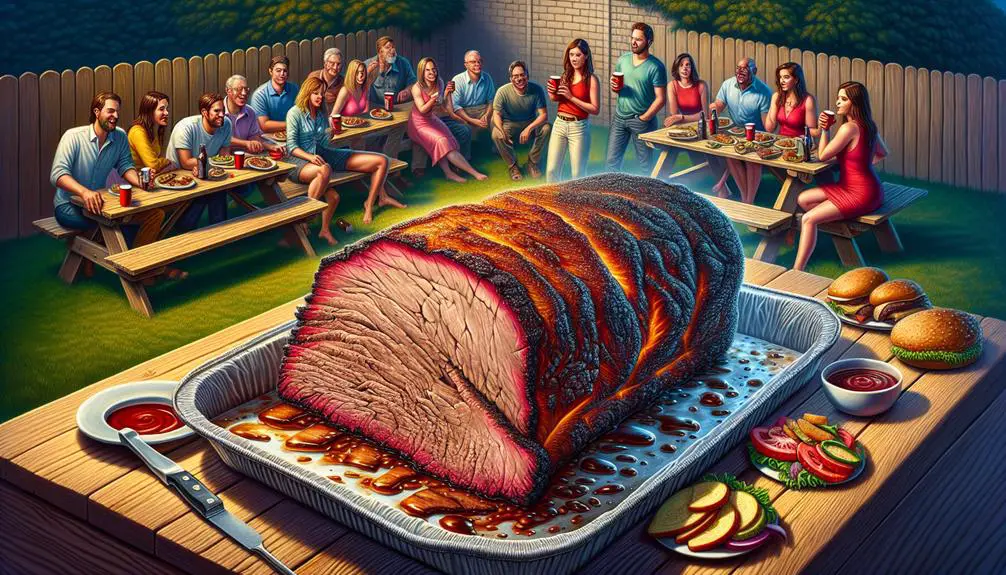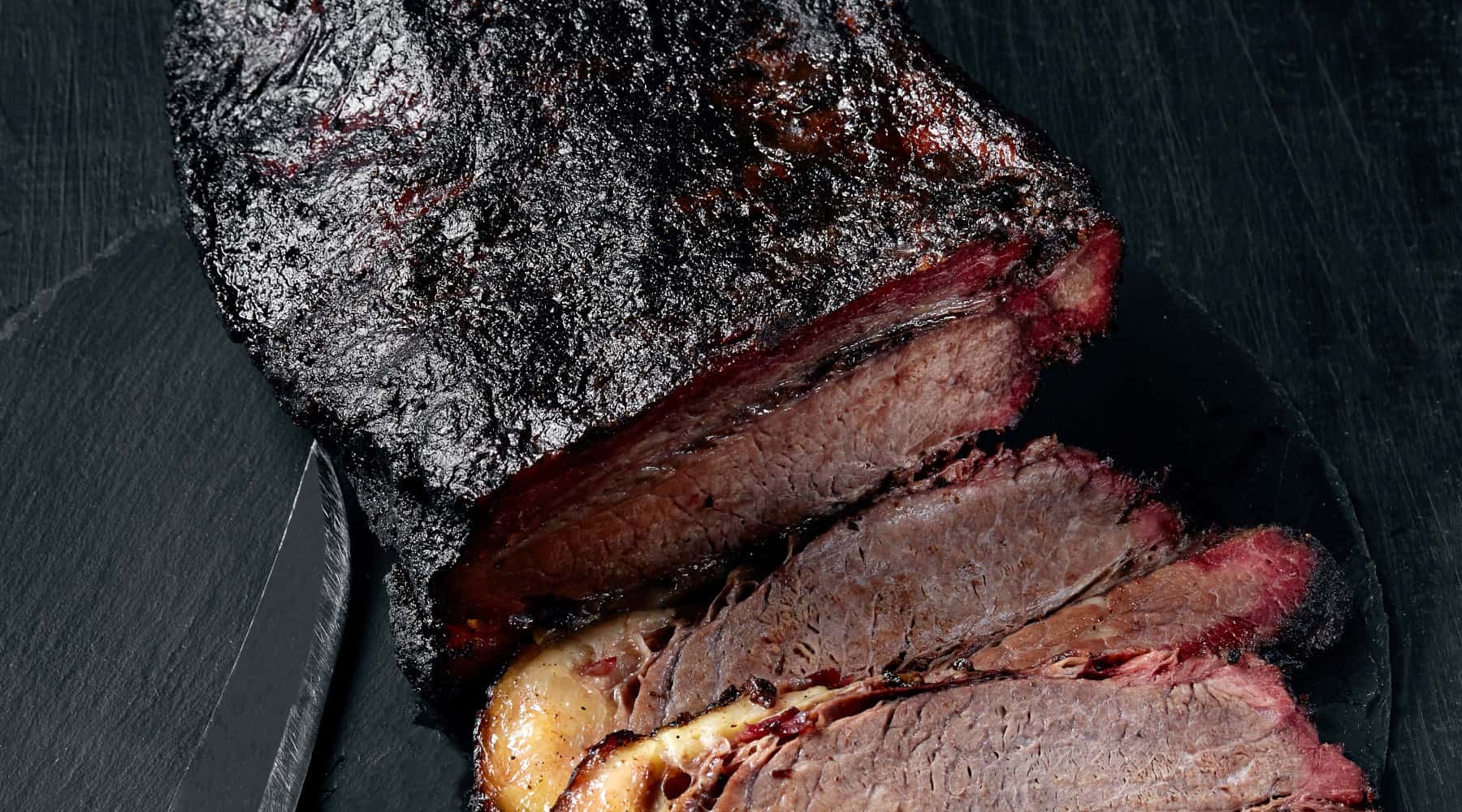Brisket Too Early? Caution: What's In Store
If you wrap brisket too early it can cause the meat to become soggy and the bark to be less flavorful.
Wrapping brisket is a common technique used to help the meat cook more evenly and retain moisture. However, if you wrap the brisket too early, it can actually have the opposite effect. The moisture from the brisket will be trapped inside the wrapping, which can make the meat soggy. Additionally, the bark of the brisket will not be able to develop properly, resulting in a less flavorful piece of meat.
So, when is the best time to wrap a brisket? It depends on the size and thickness of the brisket, but a good rule of thumb is to wait until the internal temperature of the meat has reached 165 degrees Fahrenheit. At this point, the brisket will be about halfway cooked and will benefit from being wrapped. The wrapping will help the brisket to cook more evenly and retain moisture, while still allowing the bark to develop properly.
- Remembering Frank Fritz Funeral Arrangements
- Jason Aldean Country Musics Top Star New Music Tour Dates
Here are some additional tips for wrapping brisket:
- Use a butcher paper or aluminum foil to wrap the brisket. Butcher paper is more breathable than aluminum foil, which will allow the bark to develop more.
- Wrap the brisket tightly, but not too tightly. You want the brisket to be snugly wrapped, but you don't want to crush it.
- Place the wrapped brisket back in the smoker or oven and continue cooking until the internal temperature of the meat has reached 203 degrees Fahrenheit.
what happens if you wrap brisket too earlyIntroduction
Facets of "what happens if you wrap brisket too early"
Practical Applications of "what happens if you wrap brisket too early"
what happens if you wrap brisket too early
Wrapping brisket too early can have several negative consequences, affecting the texture, flavor, and overall quality of the meat. Here are seven key aspects to consider:
- Soggy bark: Wrapping the brisket too early prevents the bark from developing properly, resulting in a less flavorful and crispy exterior.
- Steamed meat: The trapped moisture can cause the brisket to steam rather than smoke, leading to a less desirable texture.
- Loss of smoke flavor: The wrapping blocks the smoke from penetrating the meat, resulting in a less smoky flavor.
- Delayed rendering: The fat in the brisket needs time to render and contribute flavor. Wrapping too early can slow down this process.
- Uneven cooking: Wrapping the brisket too early can lead to uneven cooking, with the center of the meat being overcooked while the edges remain undercooked.
- Stalled cooking: The wrapping can insulate the brisket and prevent it from reaching the desired internal temperature, stalling the cooking process.
- Increased cooking time: Wrapping the brisket too early can extend the overall cooking time, as the meat needs to cook through the added layer of wrapping.
To avoid these negative consequences, it is important to wait until the brisket has developed a good bark and has reached an internal temperature of at least 165 degrees Fahrenheit before wrapping. This will ensure that the brisket cooks evenly, develops a flavorful bark, and retains its moisture without becoming soggy.
Soggy bark
The bark of a brisket is what gives it its characteristic flavor and texture. It is formed when the meat is exposed to smoke and heat, and it is important to allow the bark to develop properly before wrapping the brisket. If the brisket is wrapped too early, the bark will not be able to form properly and the meat will be less flavorful and crispy.
There are a few reasons why wrapping the brisket too early can prevent the bark from developing properly. First, the wrapping material can block the smoke from reaching the meat. This means that the meat will not be able to absorb as much smoke flavor, and the bark will be less flavorful. Second, the wrapping material can create a moist environment around the meat. This can cause the bark to become soggy and less crispy.
To avoid soggy bark, it is important to wait until the brisket has developed a good bark before wrapping it. This will ensure that the bark is flavorful and crispy, and that the meat is cooked evenly throughout.
Here are some tips for developing a good bark on your brisket:
- Use a dry rub on the brisket before smoking it. This will help to create a flavorful crust.
- Smoke the brisket at a low temperature (225-250 degrees Fahrenheit) for several hours. This will allow the bark to develop slowly and evenly.
- Do not wrap the brisket until it has developed a good bark. This will help to ensure that the bark remains crispy.
Steamed meat
Wrapping brisket too early can lead to steamed meat, which has a less desirable texture than smoked meat. This is because the trapped moisture prevents the smoke from penetrating the meat, resulting in a less flavorful and smoky brisket. Additionally, the steam can make the brisket soggy and mushy.
To avoid steamed meat, it is important to wait until the brisket has developed a good bark before wrapping it. This will allow the smoke to penetrate the meat and create a flavorful crust. Once the brisket has a good bark, it can be wrapped in butcher paper or aluminum foil to help it cook more evenly and retain moisture.
Here are some additional tips to avoid steamed meat:
- Use a dry rub on the brisket before smoking it. This will help to create a flavorful crust and prevent the meat from steaming.
- Smoke the brisket at a low temperature (225-250 degrees Fahrenheit) for several hours. This will allow the smoke to penetrate the meat slowly and evenly.
- Do not wrap the brisket too tightly. This will prevent the smoke from circulating and can lead to steamed meat.
By following these tips, you can ensure that your brisket is smoked to perfection and has a delicious, flavorful crust.
Loss of smoke flavor
Wrapping brisket too early can lead to a loss of smoke flavor, as the wrapping material blocks the smoke from penetrating the meat. This can result in a brisket that is less flavorful and less smoky than desired.
- Reduced exposure to smoke: When brisket is wrapped too early, it is less exposed to smoke, which can result in a less smoky flavor.
- Trapped moisture: The wrapping material can create a moist environment around the brisket, which can prevent the smoke from penetrating the meat.
- Less bark formation: Wrapping brisket too early can prevent the bark from forming properly, which can also reduce the amount of smoke flavor that the brisket absorbs.
To avoid losing smoke flavor, it is important to wait until the brisket has developed a good bark before wrapping it. This will ensure that the brisket has absorbed as much smoke flavor as possible before being wrapped.
Delayed rendering
Rendering is the process of breaking down fat into its component parts, which contributes to the flavor and texture of brisket. When brisket is cooked at a low temperature over a long period of time, the fat slowly renders and bastes the meat, resulting in a juicy and flavorful brisket.
Wrapping brisket too early can slow down this rendering process, as the wrapping material creates a barrier between the meat and the heat source. This can result in a brisket that is less flavorful and less tender, as the fat has not had enough time to render and contribute to the flavor and texture of the meat.
- Reduced fat rendering: Wrapping brisket too early can reduce the amount of fat that renders, resulting in a less flavorful and less tender brisket.
- Trapped moisture: The wrapping material can create a moist environment around the brisket, which can prevent the fat from rendering properly.
- Less flavorful meat: Brisket that is wrapped too early will have less flavor, as the fat has not had enough time to render and contribute to the flavor of the meat.
To avoid these negative consequences, it is important to wait until the brisket has developed a good bark and has reached an internal temperature of at least 165 degrees Fahrenheit before wrapping it. This will ensure that the brisket has had enough time to render and develop its full flavor and texture.
Uneven cooking
Wrapping brisket too early can lead to uneven cooking because the wrapping material creates a barrier between the meat and the heat source. This can result in the center of the meat being overcooked while the edges remain undercooked.
- Heat distribution: Wrapping brisket too early can prevent the heat from distributing evenly throughout the meat, resulting in uneven cooking.
- Stalled cooking: The wrapping material can insulate the brisket and prevent it from reaching the desired internal temperature, stalling the cooking process and leading to uneven cooking.
- Overcooked center: The center of the brisket is more likely to be overcooked when the brisket is wrapped too early, as it is not exposed to the heat source as much as the edges.
- Undercooked edges: The edges of the brisket are more likely to be undercooked when the brisket is wrapped too early, as they are not exposed to the heat source as much as the center.
To avoid uneven cooking, it is important to wait until the brisket has developed a good bark and has reached an internal temperature of at least 165 degrees Fahrenheit before wrapping it. This will ensure that the brisket cooks evenly throughout and that the center of the meat is not overcooked while the edges remain undercooked.
Stalled cooking
Wrapping brisket too early can lead to stalled cooking, which occurs when the brisket's internal temperature plateaus or even drops during the cooking process. This can be a frustrating problem, as it can significantly delay the cooking time and prevent the brisket from reaching its full potential.
There are a few reasons why wrapping brisket too early can lead to stalled cooking. First, the wrapping material can insulate the brisket and prevent it from absorbing heat from the smoker or oven. This can cause the brisket's internal temperature to rise more slowly, or even to stall completely.
Second, the wrapping material can create a moist environment around the brisket. This can prevent the brisket from forming a proper bark, which is an important part of the cooking process. A good bark helps to seal in the brisket's juices and prevents it from drying out. Without a proper bark, the brisket is more likely to stall during cooking.
To avoid stalled cooking, it is important to wait until the brisket has developed a good bark before wrapping it. This will help to ensure that the brisket cooks evenly and reaches its desired internal temperature.
Here are some additional tips to avoid stalled cooking:
- Use a dry rub on the brisket before smoking it. This will help to create a flavorful crust and prevent the brisket from steaming.
- Smoke the brisket at a low temperature (225-250 degrees Fahrenheit) for several hours. This will allow the smoke to penetrate the meat slowly and evenly.
- Do not wrap the brisket too tightly. This will prevent the smoke from circulating and can lead to steamed meat.
By following these tips, you can avoid stalled cooking and ensure that your brisket cooks evenly and reaches its full potential.
Increased cooking time
Wrapping brisket too early can lead to increased cooking time because the wrapping material acts as an insulator, preventing heat from reaching the meat as quickly. This can result in the brisket taking longer to reach its desired internal temperature, extending the overall cooking time.
For example, if a brisket is wrapped in butcher paper or aluminum foil too early, the meat may take an additional 1-2 hours to cook through. This is because the wrapping material slows down the evaporation of moisture from the surface of the meat, which in turn slows down the cooking process.
To avoid increased cooking time, it is important to wait until the brisket has developed a good bark before wrapping it. A good bark helps to seal in the brisket's juices and prevents it from drying out. Once the brisket has a good bark, it can be wrapped in butcher paper or aluminum foil to help it cook more evenly and retain moisture.
By waiting to wrap the brisket until it has developed a good bark, you can avoid increased cooking time and ensure that your brisket cooks evenly and reaches its desired internal temperature.
FAQs about "what happens if you wrap brisket too early"
Question 1: Why is it important to wait until the brisket has a good bark before wrapping it?
Answer: A good bark helps to seal in the brisket's juices and prevents it from drying out. Wrapping the brisket too early can prevent the bark from forming properly, which can lead to a less flavorful and less juicy brisket.
Question 2: What are the negative consequences of wrapping brisket too early?
Answer: Wrapping brisket too early can lead to a number of negative consequences, including soggy bark, steamed meat, loss of smoke flavor, delayed rendering, uneven cooking, stalled cooking, and increased cooking time.
Summary: It is important to wait until the brisket has developed a good bark before wrapping it. This will help to ensure that the brisket cooks evenly, develops a flavorful bark, and retains its moisture without becoming soggy.
Conclusion
Wrapping brisket too early can have several negative consequences, including soggy bark, steamed meat, loss of smoke flavor, delayed rendering, uneven cooking, stalled cooking, and increased cooking time. Therefore, it is important to wait until the brisket has developed a good bark before wrapping it.
By following the tips and advice outlined in this article, you can avoid these negative consequences and ensure that your brisket turns out moist, flavorful, and delicious.
- Anant Ambani Biography A Deep Dive Into The Future Of Reliance
- Superbad Actors Hilarious Cast Revealed

Can you wrap a brisket too early? Pastime Bar And Grill

Is Wrapping Brisket Too Early Ruining Your Backyard BBQ? Dream

Brisket Done Too Early What You Can Do